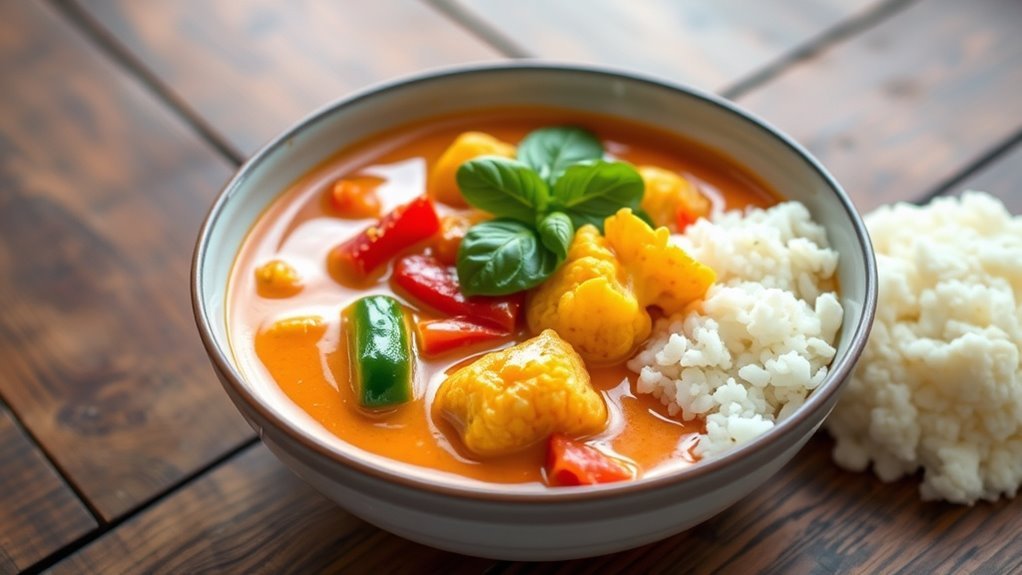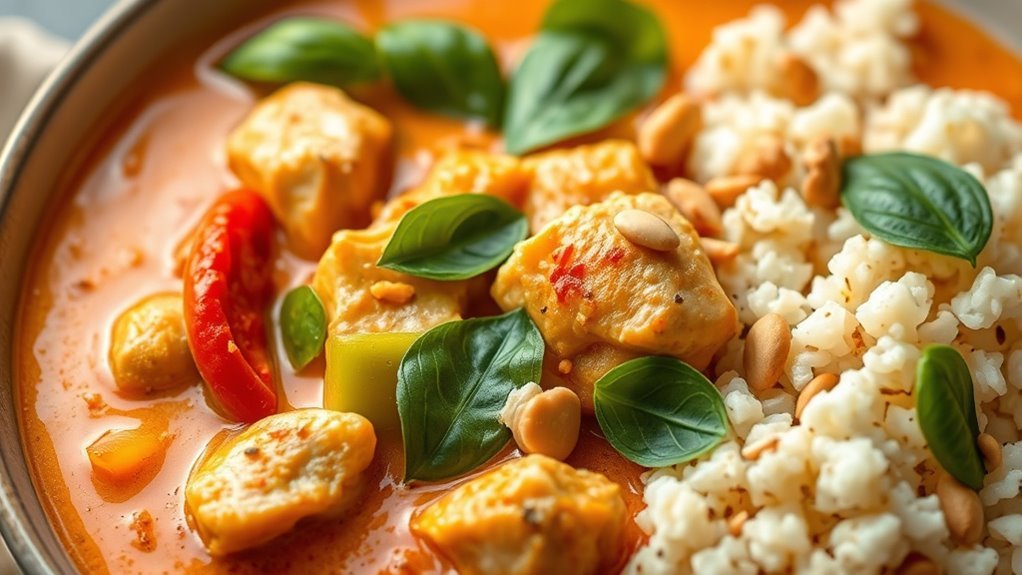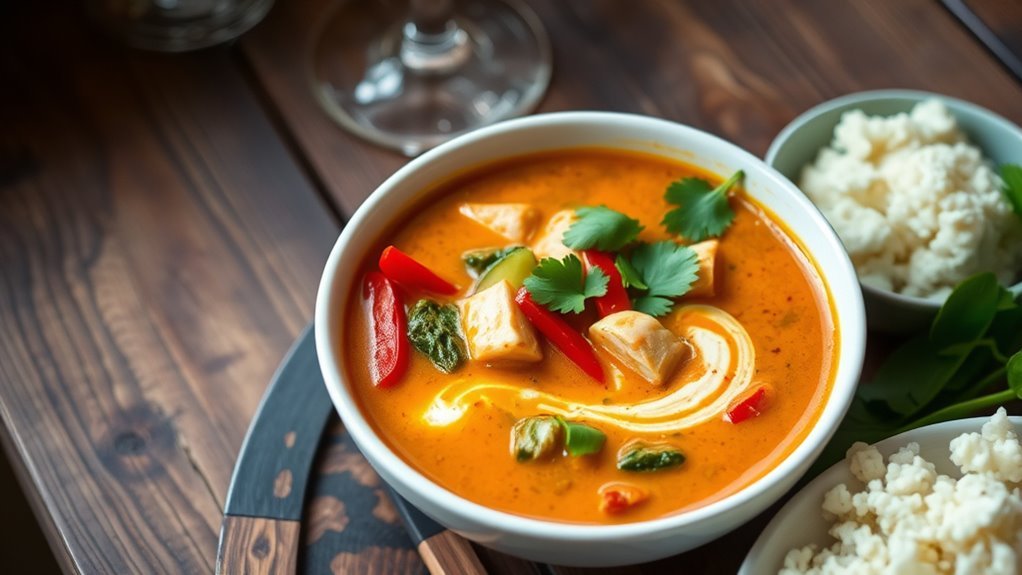Yes, Thai curry can be made keto-friendly with some mindful ingredient adjustments. By focusing on low-carb vegetables like bell peppers and zucchini, and using coconut milk for healthy fats, you can enjoy a delicious meal. Just avoid high-carb ingredients like potatoes and sugary sauces. This way, you can savor flavorful dishes that align with your dietary goals. If you want to explore tips and recipes for making keto Thai curry, keep going for more insights!
Understanding the Ketogenic Diet

Although many diets promise quick weight loss, the ketogenic diet stands out due to its unique approach to macronutrient ratios. By focusing on ketogenic principles, this diet encourages your body to enter a metabolic state called ketosis. In ketosis, your body shifts from burning carbohydrates to utilizing fats for energy, offering a different kind of freedom in meal choices. To achieve this, you’ll need to maintain a specific macronutrient balance: typically around 70% fats, 25% proteins, and only 5% carbohydrates. This shift not only aids in weight loss but can also improve mental clarity and energy levels. Embracing these principles allows you to break free from traditional dieting constraints while promoting a more sustainable lifestyle.
Common Ingredients in Thai Curry

When exploring Thai curry, you’ll find a mix of essential components that create its unique flavor profile. While there are low-carb options, certain high-carb ingredients can sneak in and affect your diet. Knowing what to look for can help you enjoy Thai curry while staying aligned with your keto goals.
Essential Curry Components
Thai curry is a vibrant blend of flavors and textures, thanks to its vital components that create a harmonious dish. At the heart of any Thai curry are aromatic curry spices, which often include ingredients like lemongrass, galangal, and kaffir lime leaves. These spices not only provide depth but also a distinct character to the curry. Coconut milk is another key element, lending creaminess and a hint of sweetness that balances the spices’ heat. You’ll also find fresh vegetables and proteins, such as chicken, shrimp, or tofu, making the dish satisfying and nutritious. By understanding these essential components, you can appreciate the complexity of Thai curry while experimenting with it in your own cooking endeavors.
Low-Carb Options Available
While exploring low-carb options in Thai curry, you’ll find that many key ingredients naturally fit into a ketogenic diet. For starters, low carb vegetables like bell peppers, zucchini, and spinach are fantastic additions, providing essential nutrients while keeping carbohydrate counts low. These veggies not only enhance the dish’s flavor and texture but also contribute to your overall health. Another staple in Thai curry is coconut milk, which adds a rich creaminess without the carbs found in dairy alternatives. It’s a great source of healthy fats, perfect for maintaining ketosis. By focusing on these ingredients, you can enjoy a delicious Thai curry that aligns with your keto lifestyle, giving you the freedom to indulge without compromising your dietary goals.
High-Carb Ingredients to Avoid
To create a keto-friendly Thai curry, it’s important to know which ingredients can derail your low-carb efforts. Some common high-carb ingredients you should avoid include:
- Potatoes: Starchy and packed with carbs.
- Carrots: While nutritious, they’re higher in sugar than other veggies.
- Peas: Sweet and starchy, these add unnecessary carbs.
- Corn: Often found in curries, it’s a high-carb ingredient.
- Sugary sauces: Many Thai sauces contain added sugars that can spike your carb intake.
Carb Counts in Traditional Thai Curry

When evaluating the carb counts in traditional Thai curry, it’s important to take into account the ingredients and preparation methods that can greatly influence their nutritional profile. The carb content in a typical Thai curry can vary widely, primarily due to ingredients like coconut milk, vegetables, and sugars used in sauces. For instance, a serving of green curry may contain around 10-15 grams of carbs, depending on the specific vegetables included. Some common ingredients, like Thai basil and bell peppers, are lower in carbs, while others, like carrots and peas, may increase the count. If you’re looking to enjoy Thai curry while on a keto diet, consider ingredient alternatives that minimize carb content without sacrificing flavor.
Keto-Friendly Alternatives for Thai Curry
Adjusting your Thai curry to fit a keto lifestyle is definitely achievable with some thoughtful ingredient swaps. You can still enjoy the rich flavors and comforting textures without compromising your dietary goals. Here are some keto-friendly alternatives to take into account:
- Use coconut milk for a creamy base that’s low in carbs.
- Opt for fresh vegetables like zucchini, bell peppers, and spinach for added nutrients.
- Incorporate protein sources like chicken, shrimp, or tofu, which are low in carbs.
- Choose spice blends that don’t contain added sugars, such as curry powder or Thai chili paste.
- Replace rice with cauliflower rice to keep your meal light and keto-approved.
These adjustments will allow you to savor your Thai curry while staying true to your keto journey.
Tips for Making Thai Curry Low-Carb
While creating a low-carb Thai curry may seem challenging, it can actually be quite straightforward with the right strategies in place. Start by using coconut milk as a creamy base; it’s low in carbs and adds richness. Incorporate plenty of fresh herbs like basil, cilantro, and mint to elevate flavor without adding carbs. Choose protein sources such as chicken, shrimp, or tofu, and load up on non-starchy vegetables like bell peppers, zucchini, and spinach. Avoid traditional ingredients like sugar and high-carb sauces; instead, opt for fish sauce or tamari for umami. Finally, keep an eye on portion sizes to guarantee you stay within your carb limits. With these tips, you can enjoy a delicious, low-carb Thai curry that satisfies your cravings.
Flavor Enhancers for Keto Thai Curry
Enhancing the flavor of your keto Thai curry can be achieved through several key ingredients that pack a punch without adding carbs. Incorporating these elements can elevate your dish while keeping it low in carbohydrates.
Elevate your keto Thai curry with low-carb ingredients that enhance flavor without sacrificing your diet.
- Coconut milk for a creamy base and rich flavor
- Spice blends like curry or garam masala to kick up the heat
- Fresh herbs such as basil or cilantro for a fragrant finish
- Lime juice to add a zesty brightness
- Fish sauce for that umami depth
You might also consider adding chili paste, garlic powder, and ginger root to further intensify the flavors. With these enhancements, your keto Thai curry will be both delicious and satisfying, allowing you to enjoy your culinary freedom.
Nutritional Benefits of Keto Thai Curry
When considering the nutritional benefits of Keto Thai curry, you’ll find it packed with low-carb ingredients that support weight loss. Additionally, the use of healthy fats from coconut milk and oils can enhance your overall well-being. Plus, the variety of vegetables and spices in the dish contributes to its nutrient density, making it a satisfying choice for a keto diet.
Low-Carb Ingredients Overview
Many people may not realize that Thai curry can be tailored to fit a ketogenic diet by incorporating low-carb ingredients that offer both flavor and nutritional benefits. By choosing the right components, you can enjoy a delicious dish without compromising your diet. Here are some low-carb ingredients to take into account:
- Zucchini: A versatile low-carb vegetable that absorbs flavors beautifully.
- Bell Peppers: Crunchy, colorful, and rich in vitamins.
- Mushrooms: Earthy and meaty, adding depth to your curry.
- Coconut Milk: Creamy and satisfying, it provides healthy fats.
- Keto Spices: Such as turmeric and cumin, enhancing flavor without carbs.
Incorporating these ingredients guarantees your Thai curry remains both keto-friendly and delicious, allowing you to enjoy your meals freely.
Healthy Fats Source
Incorporating healthy fats into your Thai curry not only elevates the dish’s flavor but also aligns perfectly with the principles of a ketogenic diet. Using healthy oils like coconut cream, you add rich creaminess while benefiting from medium-chain triglycerides (MCTs) that can boost energy. Avocado benefits are another excellent addition, providing monounsaturated fats that promote heart health. Nut oils, such as almond or walnut oil, can enhance the dish’s taste and nutritional profile.
| Healthy Fats | Benefits | Usage in Thai Curry |
|---|---|---|
| Coconut Cream | High in MCTs | Base for curries |
| Avocado | Heart-healthy fats | Topping or mixed in |
| Almond Oil | Rich in vitamin E | Drizzle for flavor |
| Walnut Oil | Omega-3 fatty acids | Enhance nuttiness |
| Olive Oil | Antioxidants | Sautéing ingredients |
Nutrient Density Benefits
While you might think of Thai curry primarily as a flavor-packed dish, it also offers an impressive array of nutrient density that aligns well with a ketogenic lifestyle. Loaded with vibrant ingredients, this dish can enhance your nutrient absorption and promote metabolic efficiency.
Consider the benefits of:
- Fresh herbs like cilantro and basil, rich in antioxidants
- Coconut milk, providing medium-chain triglycerides (MCTs) for quick energy
- Colorful vegetables like bell peppers and spinach, packed with vitamins and minerals
- Lean proteins such as chicken or shrimp, essential for muscle maintenance
- Spices like turmeric, known for their anti-inflammatory properties
Incorporating Keto Thai curry into your meal plan not only satisfies your taste buds but also supports your health goals. Enjoy the freedom of delicious, nutrient-dense eating!
Delicious Keto Thai Curry Recipes to Try
If you’re looking to indulge in the rich flavors of Thai cuisine without straying from your keto goals, there are plenty of delicious recipes to explore. One option is a coconut milk-based curry featuring chicken and vibrant vegetables like bell peppers and zucchini. This dish benefits from the aromatic touch of Thai basil, enhancing its authenticity. Another tasty choice is shrimp curry, which combines coconut milk with spices, lime juice, and fresh herbs for a zesty kick. You can also try a vegetarian version using tofu and a variety of low-carb veggies. Each recipe maintains the essential flavors of Thai cooking while keeping your carb count in check. Enjoy experimenting and savor the freedom of keto-friendly Thai dishes!
Frequently Asked Questions
Can I Use Coconut Milk in a Keto Thai Curry?
Yes, you can use coconut milk in a keto Thai curry. It’s not only creamy and delicious, but it also offers numerous coconut milk benefits, like healthy fats and essential nutrients. If you’re looking for keto-friendly alternatives, consider using unsweetened coconut milk or even alternatives like almond milk for a lighter option. Ultimately, by incorporating coconut milk, you’re embracing flavor while maintaining your dietary goals, allowing you the freedom to enjoy your meal without compromise.
Is Thai Curry Suitable for Meal Prep on Keto?
Yes, Thai curry can be suitable for keto meal prep! When you’re planning your keto meals, consider how you store the curry. Use airtight containers to maintain freshness and prevent spoilage. The flavors often improve after a day or two, making it a delicious option for leftovers. Just watch out for high-carb ingredients; stick to low-carb vegetables and proteins. This way, you can enjoy your meal prep freedom while staying on track!
How Spicy Is Traditional Thai Curry?
Traditional Thai curry can vary considerably in spice levels, often ranging from mild to very spicy. It’s all about the balance of flavor profiles; a good Thai curry combines heat with sweetness, sourness, and saltiness. If you’re sensitive to spice, you might want to start with a milder version and adjust to your taste. Ultimately, enjoying these unique flavors allows you to experience the rich culinary diversity Thailand has to offer.
Are There Vegetarian Options for Keto Thai Curry?
Absolutely, there are plenty of vegetarian options for keto Thai curry! Think of it like a beautiful garden, where each vegetable substitute—like zucchini or cauliflower—blooms with flavor and low carbs. For protein options, consider tofu or tempeh to keep it satisfying. Using coconut milk as a base adds creaminess without the carbs, allowing you to enjoy a delicious, guilt-free meal that fits your keto lifestyle while still celebrating the essence of Thai cuisine.
What Side Dishes Pair Well With Keto Thai Curry?
When enjoying keto Thai curry, consider pairing it with curry accompaniments like cauliflower rice or shirataki noodles, which are low in carbs. These options provide a satisfying texture without derailing your keto goals. You might also enjoy steamed vegetables, like broccoli or zucchini, which complement the flavors beautifully. For a revitalizing touch, a side salad with a light vinaigrette can enhance your meal while keeping it keto-friendly. Enjoy the freedom to explore delicious combinations!


